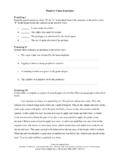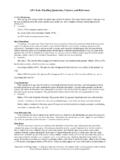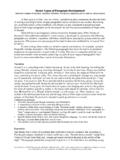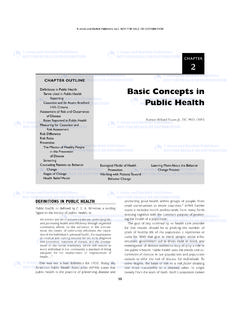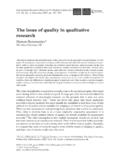Transcription of FORMALISM (also known as NEW CRITICISM) A …
1 FORMALISM (also known as new criticism ) A Basic Approach to Reading and Understanding Literature Armstrong Atlantic State University Formalist theory has dominated the American literary scene for most of the twentieth century, and it has retained its great influence in many academic quarters. Its practitioners advocate methodical and systematic readings of texts. The major premises of new criticism include: "art for art's sake," "content = form," and "texts exist in and for themselves." These premises lead to the development of reading strategies that isolate and objectify the overt structures of texts as well as authorial techniques and language usage.
2 With these isolated and objective readings, new criticism aims to classify, categorize, and catalog works according to their formal attributes. Along the way, new criticism wants to pull out and discuss any universal truths that literary works might hold concerning the human condition. These truths are considered by New Critics to be static, enduring, and applicable to all humanity. Leading new critics include Richards, Cleanth Brooks, Northrop Frye, John Crowe Ransom, Eliot, and Roman Jacobsen. These thinkers consider literature to be a language game in which communication becomes semi-transparent.
3 They reject Impressionism, moral tones, and philological studies, and believe that written works should work mostly on the intellect. The rise of new criticism coincides with that of modern literature, probably because of the popularity of the "art for art's sake" maxim. Formalists value poetry rich in ambiguity, irony, and intention, and want to make literary criticism a science. This last projection introduces the concept of expert readers into interpretive theory. Current theorists tend to criticize FORMALISM for this and other symptoms of narrow-mindedness; still, they cannot deny that new criticism has left a lasting impression on American literary scholarship.
4 Its terminology continues as the basis for most literary education in the United States, and other critical approaches to reading and critiquing literature depend upon readers familiarity with these terms to articulate their findings. Glossary of major Formalist literary terms Character creation and representation of fictional persons and entities antagonist the main villain antihero a central sympathetic character with significant personal flaws dynamic changing, growing, active flat not well-developed protagonist the main character with whom the audience is expected to sympathize round well-developed static not growing or changing.
5 An inactive personality symbolic caricature that is representative of certain kinds of people Figures of speech various expressive devices used in vivid writing allegory parallel story with underlying moral or message analogy extended comparison of things or events with other things and events irony paradoxical events, ideas, or attitudes that are played off against each other sarcasm making serious fun of things, ideas, people, or events satire synthesis of heavily developed ironies and sarcasms metaphor brief or extended comparison of something with something else metonymy using the story of a small, localized event to illustrate a larger social concern.
6 Comparing a part with the whole (as in "he gave up the sword" to indicate leaving a life of warfare) personification comparing inanimate things to people simile something or someone is "as a" something else symbolism using inanimate or imagined things to stand for real situations intangible imaginary or "mental" symbols tangible physical or "actual" symbols synecdoche using the narrative of a large human issue to illustrate a smaller, more particular concern; comparing a whole with one or more of its parts (as in saying "the smiling year" to indicate spring) Imagery specific details used to describe characters, situations, things, ideas, or events hearing images that make you hear sounds in your mind seeing images that draw mental pictures FORMALISM (also known as new criticism )
7 A Basic Approach to Reading and Understanding Literature Armstrong Atlantic State University smelling images that bring the memories of odors and aromas to mind tasting images that make you recall or imagine how something might taste touching images that help you imagine how something might feel on your skin extrasensory images that take you to an imaginary world of sensations Plot a series of events or happenings that organize a text climax the point of highest dramatic tension in a text complicated characterized by many twists and turns conflict plot features that demonstrate human rivalries and difficulties, whether internal or external external conflicts that are active, perhaps physical or overtly expressed internal conflicts that are passive, perhaps mental or covertly expressed d nouement final part of a play, movie, or narrative in which the strands of the plot are drawn together and matters are explained or resolved.
8 Foreshadowing plot features that predict other events, such as the climax or d nouement implausible fantastic plots that are not acceptable in the everyday sense of reality inciting event event that marks the beginning of a course of action plausible believable, everyday plots recognition events that reveal aspects of a character in a new light reversal events that mark a turnabout of fortune for a character simple arranged with few twists and turns Point of view perspective of the controlling narrative voice first person narrative voice that speaks with "I/we/us" pronouns limited omniscience narrator who doesn't know everything objective narrator who tries to tell the story from an impersonal point of view omniscient narrator who presumes to know the ultimate truth of the story reliable narrator who can be trusted
9 To tell the truth and be objective subjective narrator whose personal viewpoint has skewed the telling of the story third person narrative voice that uses "he/she/they" pronouns unreliable narrator who cannot be trusted to tell the truth or be objective Setting atmosphere, historical period, physical setting, or mood of text place physical or psychical locations of events, things, characters, and historical times time physical or psychical progression of events ahistorical not grounded in any "real" historical period; imaginary or fantastic chronological linear telling of events backward starting at the end and working toward the beginning forward starting at the beginning and working toward the end circular a reflection that begins anywhere, goes to the end, works its way to the beginning.
10 And eventually gets back to where it started flashbacks looking back into time historical grounded in a "real" historical time period in media res beginning more or less in the middle of events projections looking forward into time fragmented going back and forth in time with combinations of chronologies atmosphere physical and external descriptions that help us better understand the setting mood emotional and internal descriptions that help us better understand the setting Theme a major idea or message in the text controlling idea the organizing theme of a work related ideas subthemes that contribute to the development of the main idea separate issues ideas not directly related to the main idea or subthemes, but that are nevertheless important and contribute to the overall success of the text
